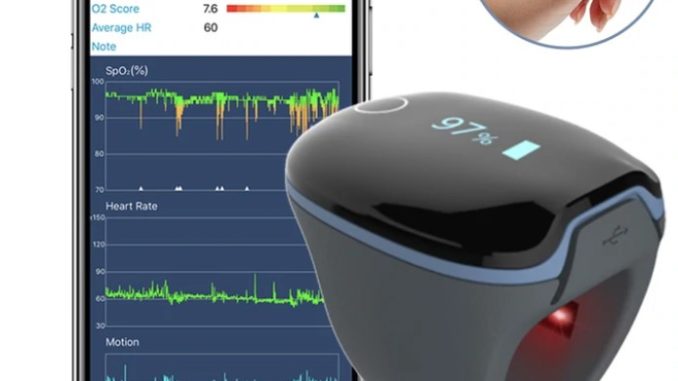
by Larry Magid
This post first appeared in the Mercury News

If you’ve had a checkup, a medical professional may have clipped a device to your finger to measure your oxygen saturation (SpO2) and pulse. Until last year, that was my only experience with such devices, but during the pandemic, I and many others purchased our own pulse oximeters to check at home for possible signs of COVID 19 or other respiratory issues. They can be found online for as little as $15, but, as the FDA warns, “although pulse oximetry is useful for estimating blood oxygen levels, pulse oximeters have limitations and a risk of inaccuracy under certain circumstances that should be considered.” The agency points out several factors that can affect the accuracy of a pulse oximeter reading, “such as poor circulation, skin pigmentation, skin thickness, skin temperature, current tobacco use, and use of fingernail polish.” A study of six inexpensive pulse oximeters, as reported in the journal Anesthesia & Analgesia found that “Many low-cost pulse oximeters sold to consumers demonstrate highly inaccurate readings.”
I bought the Zacurate 500BL Fingertip Pulse Oximeter on Amazon for $15 and brought it with me to a doctor’s appointment. The doctor’s medical grade oximeter showed my SpO2 at 100 while the home device showed 97. SPo2 levels can change minute to minute or even second to second so, if I had done this comparison at a different time, I might have gotten different results.
Levels while sleeping
Most clip-on monitors only show you your SpO2 in real time which, of course, means you have to be awake to read the screen. But there are some that have a memory and a Bluetooth connection to a smartphone, allowing you to track your SpO2 over time, including while sleeping. Also, some fitness bands and smart watches measure SpO2, including several of the higher-end Fitbit models and the Apple Watch series 6.
I generally wear a Fitbit Sense ($200) to bed and, for the past week, I’ve been testing the O2 Ring ($165 at GetWellue.com), one of the more popular oxygen saturation and pulse rate monitors designed to be worn while sleeping. Wellue promotes the product for people dealing with snoring, sleep apnea, COPD, pneumonia, and asthma as well as pilots who can develop oxygen deprivation at altitude. But, as I elaborate below, consult a medical professional before relying on any device.
The Fitbit gives you an average SpO2 for your night and a range of the highest and lowest readings. The watch itself shows your pulse rate in real time, and the Fitbit app shows a graph of your pulse rate over a 24-hour period. Fitbit only reports overnight SpO2 levels.
The O2 ring provides much more granular data. In addition to showing you the average, high and low for the night, its companion iOS and Android app shows the number of times it dropped 4% or more below your baseline and the number of drops per hour. There is also a graph of your SpO2, pulse and movement throughout the night or whatever time you’re wearing it. You can download that report as a PDF to read, print or email to your doctor. If you want highly granular data, you can download a spreadsheet that shows your SpO2 and pulse rate in 4 second intervals. So, if you notice a drop on the graph, you can refer to the spreadsheet to see exactly when it occurred, how long it lasted and what your rate was seconds before or after the drop. The device also lets you set alarms, so it vibrates if your SpO2 goes below whatever level (between 80% and 95%) you set, or if your pulse rate goes above or below a specified level. The vibration will likely wake you up, which may or may not be a good thing. Lookee, which sells the O2 Ring, says on its website that a vibration, “indicates you need to shift your sleeping position in order to improve breathing,” but I can’t verify the accuracy of that statement.
Too much information
I’m getting some useful information from the O2 Ring, but, when it comes to any device that measures fitness or health, I sometimes wonder if there is such a thing as TMI (too much information). I feel the same way about online health searches. Times are stressful enough these days, and we need to think about how much information we want to process and worry about, and of course, whether that information is accurate and understood in context.
Via email, I interviewed Scott Kutscher, clinical associate professor, psychiatry and behavioral sciences, who practices as a sleep medicine doctor at the Stanford Sleep Medicine Center. Kutscher said that “home oxygen monitoring can be a useful screening tool if you suspect a sleep disorder such as sleep apnea. It can also be helpful for monitoring progress on treatment,” but cautioned that such monitors “are not used to diagnose problems, so if you think they are showing something is wrong you should consult a doctor or other trained professional.” As per TMI, he said “data can lead to false assumptions or conclusions. When I ask patients how they sleep, they’ll sometimes answer ‘well, my watch says…’ but your watch can’t tell you how you slept.”
The quest for health data can sometimes be counterproductive. “In sleep medicine,” Kutchner added, “we have a term orthosomnia, which is poor sleep induced by a quest for perfect sleep.” Indeed, an article in the Journal of Sleep Medicine based on three case studies, pointed out that “sleep trackers may pose unique challenges … and reinforce sleep-related anxiety or perfectionism for some patients.
I’m not a medical doctor, but I do have a doctorate in education. And one thing most educators know is that you need to get your information from definitive sources. If you suspect you have a sleep disorder or any other medical condition, get your advice from a qualified medical professional, not from a device or a technology columnist.
Larry Magid is a tech journalist and internet safety activist.